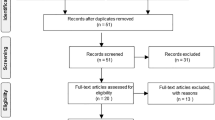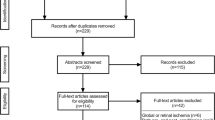Abstract
Background
The recurrent failure of apparently promising neuroprotective drugs to improve outcome in trials of patients with acute ischaemic stroke may partially be explained by overoptimistic conclusions about efficacy as a result of methodological shortcomings in preclinical studies. We assessed the methodological quality of animal studies of five different neuroprotective agents that have been tested in 21 clinical trials including a total of more than 12,000 patients with acute ischaemic stroke.
Methods
We performed a literature search restricted to full publications on the effects of clomethiazole, gavestinel, lubeluzole, selfotel, or tirilazad mesylate on infarct volume or functional outcome in animal models of acute focal cerebral ischaemia. We used a rating scale to assess the methodological quality of the included studies. One point was attributed to each of 10 items. A score of 4 to 6 points was considered “medium” and a score above 7 “high.”
Results
A total of 45 articles were included. The median score on the methodological quality index was 3; 18 studies had a medium score and one a high score. Randomised treatment allocation was mentioned in 19 studies (42 %), blinded administration of study medication in 10 (22 %), and blinded outcome assessment in 18 (40 %). The study drug was administered at a median of 10 min (range, –60 to 360 min) after the onset of ischaemia.
Conclusion
The evidence for neuroprotective efficacy that formed the basis for initiating the 21 trials was obtained in animal studies with a methodological quality that would, in retrospect, not justify such a decision. More rigorous preclinical study methodology may lead to more reliable and reproducible results.
Similar content being viewed by others
References
Barber PA, Zhang J, Demchuk AM, Hill MD, Buchan AM (2001) Why are stroke patients excluded from TPA therapy? An analysis of patient eligibility. Neurology 56:1015–1020
Bath PM, Iddenden R, Bath FJ, Orgogozo J-M, Tirilazad International Steering Committee (2001) Tirilazad for acute ischaemic stroke. Cochrane Database Syst Rev CD002087
Bebarta V, Luyten D, Heard K (2003) Emergency medicine animal research: Does use of randomization and blinding affect the results? Acad Emerg Med 10:684–687
CAST (Chinese Acute Stroke Trial) Collaborative Group (1997) CAST: randomised placebo-controlled trial of early aspirin use in 20000 patients with acute ischaemic stroke. Lancet 349:1641–1649
Chang ML, Yang J, Kem S, Klaidman L, Sugawara T, Chan PH, Adams JD Jr (2002) Nicotinamide and ketamine reduce infarct volume and DNA fragmentation in rats after brain ischemia and reperfusion. Neurosci Lett 322:137–140
Drummond JC, Piyash PM, Kimbro JR (2000) Neuroprotection failure in stroke. Lancet 356:1032–1033
Easterbrook PJ, Berlin JA, Gopalan R, Matthews DR (1991) Publication bias in clinical research. Lancet 337:867–872
Festing MF (2003) Principles: the need for better experimental design. Trends Pharmacol Sci 24:341–345
Fisher M (2003) Recommendations for advancing development of acute stroke therapies: Stroke Therapy Academic Industry Roundtable 3. Stroke 34:1539–1546
Gandolfo C, Sandercock P, Conti M (2002) Lubeluzole for acute ischaemic stroke. Cochrane Database Syst Rev CD001924
Gladstone DJ, Black SE, Hakim AM, Heart and Stroke Foundation of Ontario Centre of Excellence in Stroke Recovery (2002) Toward wisdom from failure. Lessons from neuroprotective stroke trials and new therapeutic directions. Stroke 33:2123–2136
Grotta J (1995) Why do all drugs work in animals but none in stroke patients? 2 Neuroprotective therapy. J Intern Med 237:89–94
Grotta J (2001) Neuroprotection is unlikely to be effective in humans using current trial designs. Stroke 33:306–307
Haelewyn B, Yvon A, Hanouz JL, MacKenzie ET, Ducouret P, Gerard JL, Roussel S (2003) Desflurane affords greater protection than halothane against focal cerebral ischaemia in the rat. Br J Anaesth 91:390–396
Hankey GJ (2002) Clomethiazole: an unsuccessful bachelor, but perhaps a properous married man? Stroke 33:128–129
Horn J, de Haan RJ, Vermeulen M, Luiten PGM, Limburg M (2001) Nimodipine in animal model experiments of focal cerebral ischemia. Stroke 32:2433–2438
International Stroke Trial Collaborative Group (1997) The International Stroke Trial (IST): a randomised trial of aspirin, subcutaneous heparin, or both, or neither among 19435 patients with acute ischaemic stroke. Lancet 349:1569–1581
Ioannidis JPA, Haidich A-B, Pappa M, Pantazis N, Kokori SI, Tektonidou MG, Contopoulos-Ioannidis DG, Lau J (2001) Comparison of evidence of treatment effects in randomized and nonrandomized studies. JAMA 286:821–830
Kawaguchi M, Kimbro JR, Drummond JC, Cole DJ, Kelly PJ, Patel PM (2000) Isoflurane delays but does not prevent cerebral infarction in rats subjected to focal ischemia. Anesthesiol 92:1335–1342
Kidwell CS, Liebeskind DS, Starkman S, Saver JL (2001) Trends in acute ischemic stroke trials through the 20th century. Stroke 32:1349–1359
Lees KR (2002) Neuroprotection is unlikely to be effective in humans using current trial designs: an opposing view. Stroke 33:308–309
Lees KR, Asplund K, Carolei A, Davis SM, Diener H-C, Kaste M, Orgogozo JM, Whitehead J, for the GAIN International Investigators (2000) Glycine antagonist (gavestinel) in neuroprotection (GAIN International) in patients with acute stroke: a randomised controlled trial. Lancet 355:1949–1954
Lees KR, Hankey GJ, Hacke W (2003) Design of future acute-stroke treatment trials. Lancet Neurol 2:54–61
Liebeskind DS, Kasner SE (2001) Neuroprotection for ischaemic stroke: an unattainable goal? CNS Drugs 15:165–174
Macleod MR, O’Collins T, Howells DW, Donnan GA (2004) Pooling of animal experimental data reveals influence of study design and publication bias. Stroke 35:1203–1208
Miettinen OS (1983) The need for randomisation in the study of intended effects. Stat Med 2:267–271
Muir KW, Lees KR (2003) Excitatory amino acid antagonists for acute stroke. Cochrane Database Syst Rev CD001244
Saver JL, Johnston KC, Homer D, Wityk R, Koroshetz W, Truskowski LL, Haley EC, The RANTTAS Investigators (1999) Infarct volume as a surrogate or auxiliary outcome measure in ischemic stroke clinical trials. Stroke 30:293–298
Schulz KF, Chalmers I, Hayes RJ, Altman DG (1995) Empirical evidence of bias.Dimensions of methodological quality associated with estimates of treatment effects in controlled trials. JAMA 273:408–412
Schulz KF, Grimes DA (2002) Blinding in randomised trials: hiding who got what. Lancet 359:696–700
Stroke Therapy Academic Industry Roundtable (STAIR) (1999) Recommendations for standards regarding preclinical neuroprotective and restorative drug development. Stroke 30:2752–2758
Stroke Therapy Academic Industry Roundtable II (STAIR II) (2001) Recommendations for clinical trial evaluation of acute stroke therapies. Stroke 32:1598–1606
The National Institute of Neurological Disorders and Stroke (NINDS) rt-PA Stroke Study Group (2000) Effect of intravenous recombinant tissue plasminogen activator on ischemic stroke lesion size measured by computed tomography. Stroke 31:2912–2919
The National Institute of Neurological Disorders and Stroke rt-PA Stroke Study Group (1995) Tissue plasminogen activator for acute ischemic stroke. N Engl J Med 333:1581–1587
Van der Worp HB, Kappelle LJ (1998) Complications of acute ischaemic stroke. Cerebrovasc Dis 8:124–132
Wardlaw JM, Warlow CP, Sandercock PAG, Dennis MS, Lindley RI (2000) Neuroprotection disappointment yet aGAIN. Lancet 356:597
Weir CJ, Kaste M, Lees KR (2004) _targeting neuroprotection clinical trials to ischemic stroke patients with potential to benefit from therapy. Stroke 35:2111–2116
Author information
Authors and Affiliations
Corresponding author
Rights and permissions
About this article
Cite this article
van der Worp, H.B., de Haan, P., Morrema, E. et al. Methodological quality of animal studies on neuroprotection in focal cerebral ischaemia. J Neurol 252, 1108–1114 (2005). https://doi.org/10.1007/s00415-005-0802-3
Received:
Revised:
Accepted:
Issue Date:
DOI: https://doi.org/10.1007/s00415-005-0802-3




